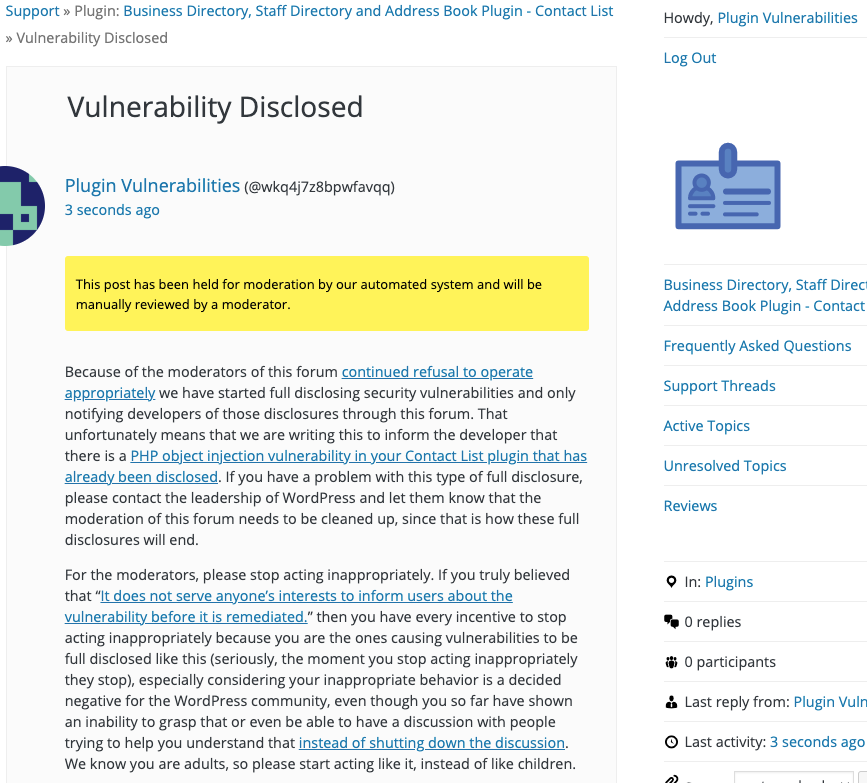Our Proactive Monitoring Caught a PHP Object Injection Vulnerability Being Introduced in to a WordPress Plugin
One way we help to improve the security of WordPress plugins, not just for our customers of our service, but for everyone using them, is our proactive monitoring of changes made to plugins in the Plugin Directory to try to catch serious vulnerabilities. Through that, we caught ones of those vulnerabilities, a PHP object injection vulnerability, being introduced in to the plugin Contact List.
The possibility of this vulnerability is also flagged by our Plugin Security Checker, so you can check plugins you use to see if they might have similar issues with that tool.
We tested and confirmed that our upcoming firewall plugin for WordPress protects against the exploitation of this vulnerability.
The automated portion of that monitoring flagged the following line of code, which was being added in two different locations, because of the possibility that it could permit PHP object injection to occur:
$atts = unserialize( stripslashes( $_POST['cl_atts'] ) ); |
That will unserialize the POST input “cl_atts”.
One of those instance runs when the function cl_get_contacts() is called:
5 6 7 8 9 10 | public function cl_get_contacts() { $html = ''; $atts = []; if ( isset( $_POST['cl_atts'] ) && $_POST['cl_atts'] ) { $atts = unserialize( stripslashes( $_POST['cl_atts'] ) ); |
That function is registered to be accessible through WordPress’ AJAX functionality to those logged in to WordPress as well as those not logged in:
334 335 | $this->loader->add_action( 'wp_ajax_nopriv_cl_get_contacts', $plugin_public_ajax, 'cl_get_contacts' ); $this->loader->add_action( 'wp_ajax_cl_get_contacts', $plugin_public_ajax, 'cl_get_contacts' ); |
Through that unserialization, PHP objection can occur, as can be confirmed with the proof of concept below.
WordPress Causes Full Disclosure
Because of the moderators of the WordPress Support Forum’s continued inappropriate behavior we changed from reasonably disclosing to full disclosing vulnerabilities for plugins in the WordPress Plugin Directory in protest, until WordPress gets that situation cleaned up, so we are releasing this post and then leaving a message about that for the developer through the WordPress Support Forum. (For plugins that are also in the ClassicPress Plugin Directory, we will follow our reasonable disclosure policy.) You can notify the developer of this issue on the forum as well. Hopefully, the moderators will finally see the light and clean up their act soon, so these full disclosures will no longer be needed (we hope they end soon). You would think they would have already done that, but considering that they believe that having plugins, which have millions installs, remain in the Plugin Directory despite them knowing they are vulnerable is “appropriate action”, something is very amiss with them (which is even more reason the moderation needs to be cleaned up).
Update: To clear up the confusion where developers claim we hadn’t tried to notify them through the Support Forum (while at the same time moderators are complaining about us doing just that), here is the message we left for this vulnerability:
Is It Fixed?
If you are reading this post down the road the best way to find out if this vulnerability or other WordPress plugin vulnerabilities in plugins you use have been fixed is to sign up for our service, since what we uniquely do when it comes to that type of data is to test to see if vulnerabilities have really been fixed. Relying on the developer’s information can lead you astray, as we often find that they believe they have fixed vulnerabilities, but have failed to do that.
Proof of Concept
With our plugin for testing for PHP object injection installed and activated, the following proof of concept will cause the message “PHP object injection has occurred.” be shown.
Replace “[path to WordPress]” with the location of WordPress.
<html>
<body>
<form action="http://[path to WordPress]/wp-admin/admin-ajax.php?action=cl_get_contacts" method="POST">
<input type="hidden" name="cl_atts" value='O:20:"PHP_Object_Injection":0:{}' />
<input type="submit" value="Submit" />
</form>
